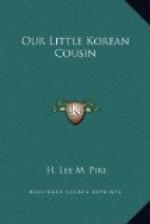“Certainly, my son; it is always proper to offer food to a guest who takes refuge under our roof.”
Quickly the boy sought his mother in the women’s apartments, and very soon returned with a steaming bowl of rice, which he placed before the visitor.
This gift of rice was especially pleasing to the traveller, as no dish is held in higher honour in Korea. It is the chief cereal, and the inhabitants say it originated in Ha-ram, China, nearly five thousand years ago. Yung Pak called it Syang-nong-si, which means Marvellous Agriculture. He had learned from Wang Ken that it was first brought to Korea in 1122 B.C.
To the monk the warm food was very refreshing, and after he had eaten a generous amount he entered into conversation with his hosts.
He told of the monastery where he made his home, and his account of the various religious ceremonies and their origin was very interesting to Yung Pak, who found that the visitor not only knew a great deal of the history of the country, but was also familiar with its fables and legends.
Like many who live in retirement and dwell in a world apart from their fellows, this monk thought the people of former times were superior to the men of his own day. Especially did he praise the kings of years long gone by.
“Do you think,” said Yung Pak, “that the old kings were any better than our own gracious ruler?”
Yung Pak was very jealous of the honour of his king.
“Why, yes,” replied the monk. “And to prove my statement let me tell you a story:
“Many years ago there was in Cho-sen a king named Cheng-chong. He was celebrated throughout his kingdom for his goodness. It was a habit with him to disguise himself in ordinary clothing and then to go out and mingle with the common people. In this way he was often able to discover opportunities for doing much good to his subjects.
“One night Cheng-chong disguised himself as a countryman, and, taking a single friend along, started out to make a tour of inspection among his people, that he might learn the details of their lives.
“Coming to a dilapidated-looking house, he suspected that within there might be miserable people to whom he could render assistance. Desiring to see the inside of the house, he punched a peep-hole in the paper door. Looking through this hole, the king perceived an old man weeping, a man in mourning garb singing, and a nun or widow dancing.
“Cheng-chong was unable to imagine the cause of these strange proceedings, so he asked his companion to call the master of the house.
“In answer to the summons, the man in mourning made his appearance. The king, with low and respectful salutation, said:
“‘We have never before met.’
“‘True,’ was the reply, ’but whence are you? How is it that you should come to find me at midnight? To what family do you belong?’
“Cheng-chong answered: ’I am Mr. Ni, living at Tong-ku-an. As I was passing before your house I was attracted by strange sounds. Then through a hole in the door I saw an old man crying, a dancing nun, and a man in mourning singing. Why did the nun dance, the bereaved man sing, and the old man weep? I have called you out on purpose to learn the reason of these things.’




